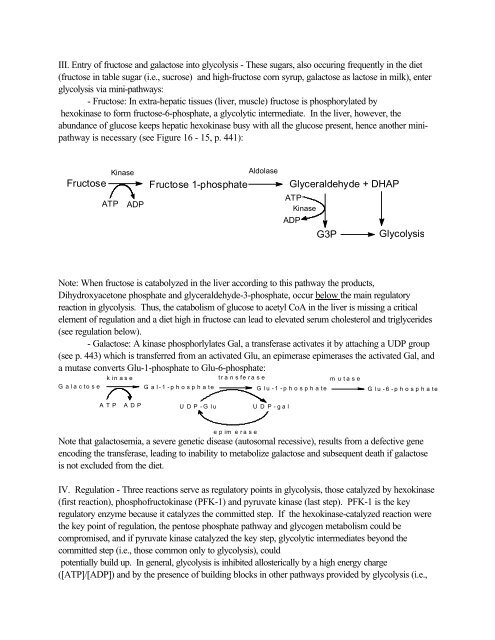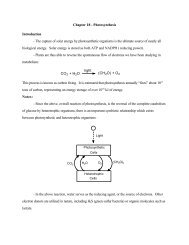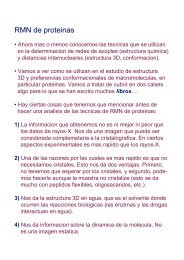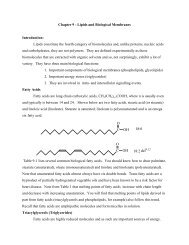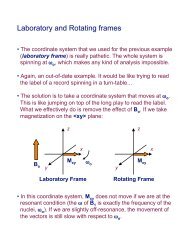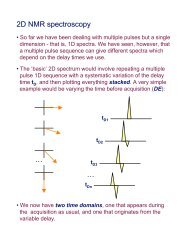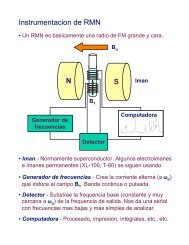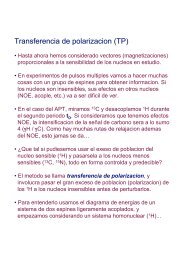Chapter16 - Glycolysis and Gluconeogenesis Topics you're not ...
Chapter16 - Glycolysis and Gluconeogenesis Topics you're not ...
Chapter16 - Glycolysis and Gluconeogenesis Topics you're not ...
You also want an ePaper? Increase the reach of your titles
YUMPU automatically turns print PDFs into web optimized ePapers that Google loves.
III. Entry of fructose <strong>and</strong> galactose into glycolysis - These sugars, also occuring frequently in the diet(fructose in table sugar (i.e., sucrose) <strong>and</strong> high-fructose corn syrup, galactose as lactose in milk), enterglycolysis via mini-pathways:- Fructose: In extra-hepatic tissues (liver, muscle) fructose is phosphorylated byhexokinase to form fructose-6-phosphate, a glycolytic intermediate. In the liver, however, theabundance of glucose keeps hepatic hexokinase busy with all the glucose present, hence a<strong>not</strong>her minipathwayis necessary (see Figure 16 - 15, p. 441):FructoseKinaseATP ADPFructose 1-phosphateAldolaseGlyceraldehyde + DHAPATPKinaseADPG3P <strong>Glycolysis</strong>Note: When fructose is catabolyzed in the liver according to this pathway the products,Dihydroxyacetone phosphate <strong>and</strong> glyceraldehyde-3-phosphate, occur below the main regulatoryreaction in glycolysis. Thus, the catabolism of glucose to acetyl CoA in the liver is missing a criticalelement of regulation <strong>and</strong> a diet high in fructose can lead to elevated serum cholesterol <strong>and</strong> triglycerides(see regulation below).- Galactose: A kinase phosphorlylates Gal, a transferase activates it by attaching a UDP group(see p. 443) which is transferred from an activated Glu, an epimerase epimerases the activated Gal, <strong>and</strong>a mutase converts Glu-1-phosphate to Glu-6-phosphate:k i n a s etr a n s fe r a s eG a l a c to s e G a l - 1 - p h o s p h a te G l u - 1 - p h o s p h a tem u t a s eG l u - 6 - p h o s p h a teA T P A D P U D P - G lu U D P - g a le p im e r a s eNote that galactosemia, a severe genetic disease (autosomal recessive), results from a defective geneencoding the transferase, leading to inability to metabolize galactose <strong>and</strong> subsequent death if galactoseis <strong>not</strong> excluded from the diet.IV. Regulation - Three reactions serve as regulatory points in glycolysis, those catalyzed by hexokinase(first reaction), phosphofructokinase (PFK-1) <strong>and</strong> pyruvate kinase (last step). PFK-1 is the keyregulatory enzyme because it catalyzes the committed step. If the hexokinase-catalyzed reaction werethe key point of regulation, the pentose phosphate pathway <strong>and</strong> glycogen metabolism could becompromised, <strong>and</strong> if pyruvate kinase catalyzed the key step, glycolytic intermediates beyond thecommitted step (i.e., those common only to glycolysis), couldpotentially build up. In general, glycolysis is inhibited allosterically by a high energy charge([ATP]/[ADP]) <strong>and</strong> by the presence of building blocks in other pathways provided by glycolysis (i.e.,


